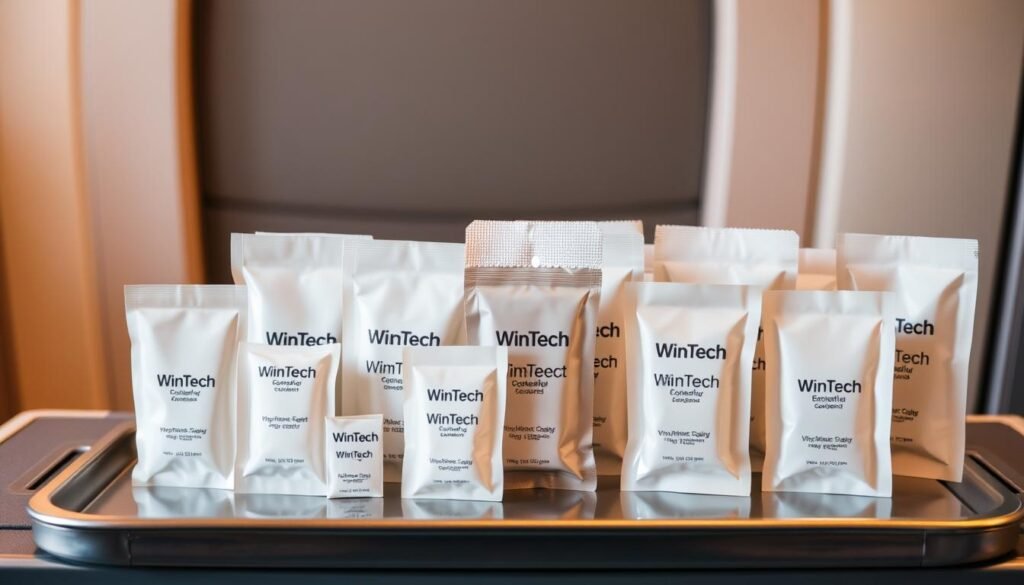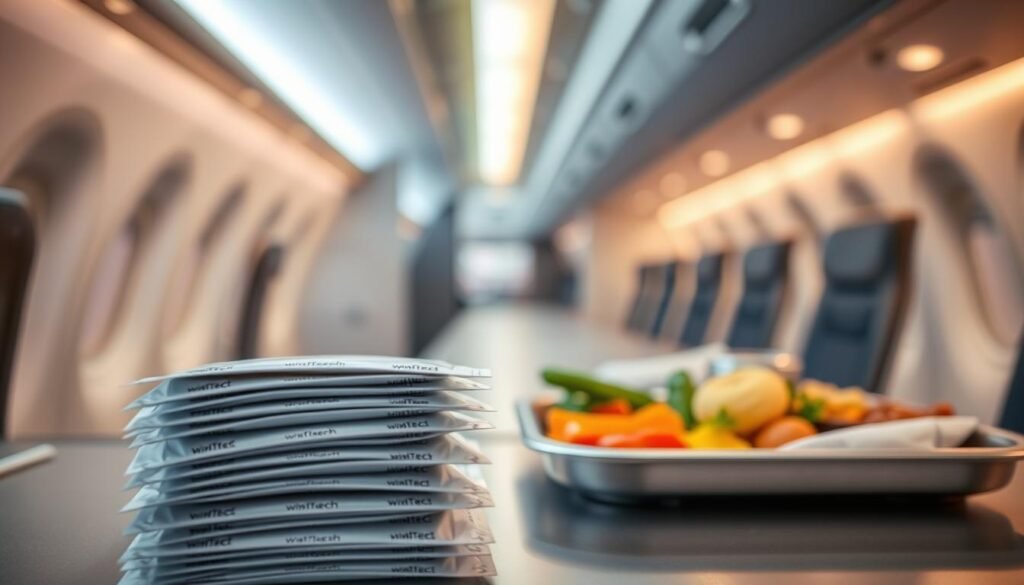Have you ever wondered how airlines manage to serve perfectly portioned meals at 35,000 feet? What are sachets transforming the in-flight dining experience in ways you might never have imagined?
The global aviation catering industry is undergoing a remarkable transformation with what are sachets. Single-use sachets packaging has become a game-changer for airlines seeking efficient and hygienic food service solutions. With the portion packs market valued at USD 10.5 billion in 2024 and projected to reach USD 15.9 billion by 2033, these innovative packaging solutions are revolutionizing how you experience meals during air travel.
What are sachets doing for airline catering? They’re solving multiple challenges simultaneously. From ensuring precise portion control to maintaining food safety and reducing waste, these compact packaging solutions are becoming an essential component of modern in-flight dining strategies.
Key Takeaways of What Are Sachets
- Sachets provide precise portion control in airline catering
- Single-use packaging enhances food safety and hygiene
- Global portion packs market shows significant growth potential
- Innovative packaging solutions improve passenger dining experience
- Sustainable packaging trends are driving sachet development
What Are Sachets and Their Importance in In-Flight Catering?
Sachets have revolutionized the way airlines manage food service, offering a compact and efficient solution for portion control and food packaging. These small, sealed packets are becoming increasingly popular in the aviation industry, representing a critical innovation in catering management.

Understanding what are sachets involves recognizing their versatility and practical applications. Sachets are typically single-use packages designed to contain precise quantities of food, condiments, or beverages. They differ from traditional packets in several key ways, providing more controlled and hygienic food distribution.
Types of Sachets in Airline Catering
The world of sachets encompasses various types tailored to specific airline needs:
- Condiment sachets for salt, pepper, and sugar
- Sauce and dressing sachets
- Beverage mix sachets
- Individually portioned snack sachets
Benefits of Sachets in Catering
Airlines appreciate sachets for their numerous advantages. They enhance food safety by minimizing contamination risks and providing single-use packaging. The types of sachets available allow for customized solutions that meet strict airline catering standards.
Portion Control Excellence
Sachets vs packets showcase a clear winner in portion control. These small packages ensure consistent serving sizes, helping airlines manage costs and maintain quality across different flights. By 2025, sachets are expected to account for 32.8% of the global food portion pack market, highlighting their growing importance.
“Sachets represent the future of precise, efficient food service in aviation.” – Catering Industry Expert
Whether you’re a frequent flyer or an airline professional, understanding what are sachets reveals their critical role in modern in-flight catering strategies.
Practical Uses of What Are Sachets in Airlines
Sachets have revolutionized in-flight catering by providing convenient, compact packaging solutions for various food and beverage items. These small, versatile packets offer airlines an efficient way to serve passengers while maintaining high standards of hygiene and portion control.

The foodservice and catering sector is projected to account for 36.5% of the food portion pack market by 2025, highlighting the growing importance of what are sachets in airline services.
Common Products Packaged as Food Sachets
Airlines utilize food sachets for a wide range of products, including:
- Condiments and sauces
- Salad dressings
- Spreads and butter
- Instant coffee and tea
- Sugar and sweetener packets
- Salt and pepper
Customer Preferences for Sachets for Samples
Passengers appreciate sachets for their unique advantages. Wintech Package, a leading provider of sachet solutions, understands the critical requirements of airline catering. Their innovative packaging offers:
- Precise portion control
- Easy-to-open designs
- Minimal waste
- Quick and clean distribution
Sachets for samples have become particularly popular, allowing airlines to introduce premium products and gather customer feedback through compact, single-serve packaging.
Advantages of What Are Sachets in Sustainable Practices
The airline industry is increasingly embracing sustainable packaging solutions, with sachets emerging as a key innovation in eco-friendly catering practices. Sachets materials are revolutionizing how airlines approach portion control and environmental responsibility.

Biodegradable sachets offer remarkable benefits for airlines seeking to reduce their environmental footprint. These innovative packaging solutions address multiple sustainability challenges:
- Minimize food waste through precise portion sizing
- Reduce overall packaging material consumption
- Lower aircraft weight, leading to decreased fuel consumption
- Support circular economy initiatives
Eco-Friendly Aspects of Sachets
Modern what are sachets technologies focus on creating environmentally conscious packaging. Manufacturers like Wintech Package are developing sachets from renewable resources, ensuring minimal environmental impact. Compostable and recyclable materials are becoming standard in sachet production.
Cost-Effectiveness of Sustainable Packaging
Airlines can achieve significant economic advantages through strategic sachet implementation. By optimizing packaging and reducing waste, carriers can realize substantial cost savings while maintaining high-quality catering standards.
Sustainable packaging is not just an environmental choice, but a smart business strategy for modern airlines.
The future of in-flight catering lies in intelligent, eco-friendly solutions that balance operational efficiency with environmental responsibility.
Future Trends Related to What Are Sachets in In-Flight Catering
The food portion pack market is poised for significant growth, with projections indicating a robust expansion to USD 6.1 billion by 2035. This trajectory underscores the increasing importance of what are sachets in modern catering solutions, particularly within the airline industry.
Technological advancements are reshaping sachets packaging, introducing smart features that go beyond traditional packaging. Innovative QR codes now enable passengers to track ingredient origins, while temperature-sensitive indicators ensure food safety and quality during flights.
Innovations in Sachet Technology
Wintech Package is at the forefront of developing cutting-edge cosmetic sachets for in-flight amenity kits. These compact solutions are not just about convenience but represent a strategic approach to personalized travel experiences. Airlines can now offer tailored hygiene and comfort products that meet individual passenger preferences.
The Evolving Role in Hospitality
The future of what are sachets extends far beyond airlines. Hotels, cruise lines, and other hospitality sectors are recognizing the potential of these versatile packaging solutions. Potential collaborations between packaging innovators and travel companies will likely drive sustainable, customized sachet technologies that enhance passenger experiences while reducing environmental impact.




